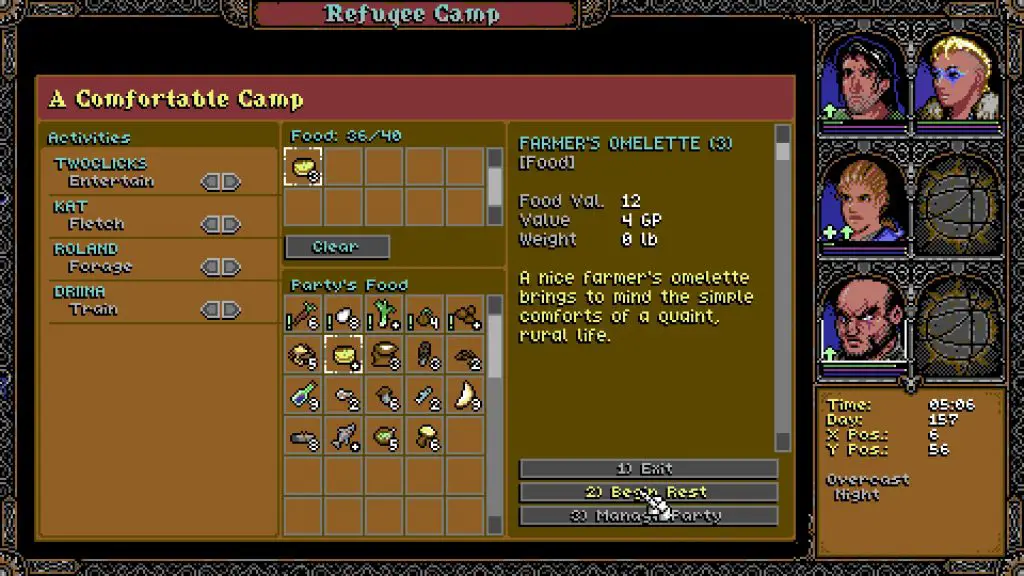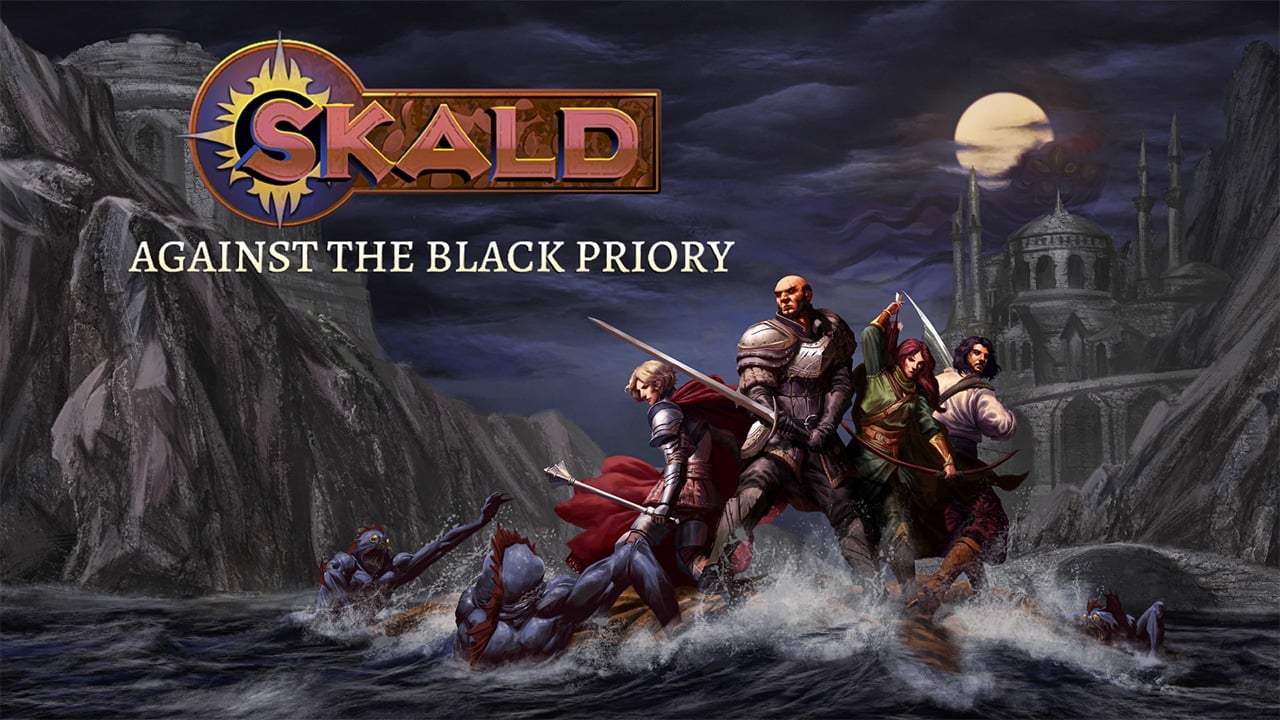SKALD: Against the Black Priory (SKLAD) has materialised from the depths of nowhere without pomp or fanfare. The first Steam release by developer High North Studios AS. Does this passion project live up to its promise? Is it every inch the retro-inspired RPG it describes itself to be, or is it just another pretender? Is the Lovecraftian-themed story and setting a horror show, or does it deliver a compelling experience? Will its turn-based tactical combat add enough strategy, or do potential flaws outweigh its fun factor? Read below to find out more…
DARK roots
► The STORY is very good, an epic tale rich in the traditions of classic RPGs. One that clutches on the coattails of classics such as Eye of the Beholder, D&D Krynn, Ultima, and Wizardry games. An added twist of horror allows it stand out. With lots of reading to do, narrative and dialogue are thankfully presented in bitesize chunks. Though the font is not particularly helpful in that respect. The WRITING holds its own across the story building up the required atmosphere for such a setting. There are the noticeable shortcomings of a non-native English speaker in a few areas, though not enough to break immersion.
► As SETTINGs go, this one comfortably sits in the category of different-but-familiar. There are no elves, dwarves, orcs or goblins. Instead, the unmistakable Lovecraftian theme touches many of the game elements to create a fresh experience. Character classes are non-traditional but derivative of stock fantasy ones. Though NPCs, spells, and inventory should be no strangers to fans of the genre.
► A well-designed GAME WORLD proves a satisfactory companion to the setting and story despite a disconnect between an empty overland map populated only with sporadic locations for quests. The game world only has random encounters of mobs and traders to give it a lived-in feel. By using a framework of isolated islands, quests at least remain relatively self-contained, thereby reducing the need to retrace steps too many times. A time-saving benefit since there is no quick-travel option.
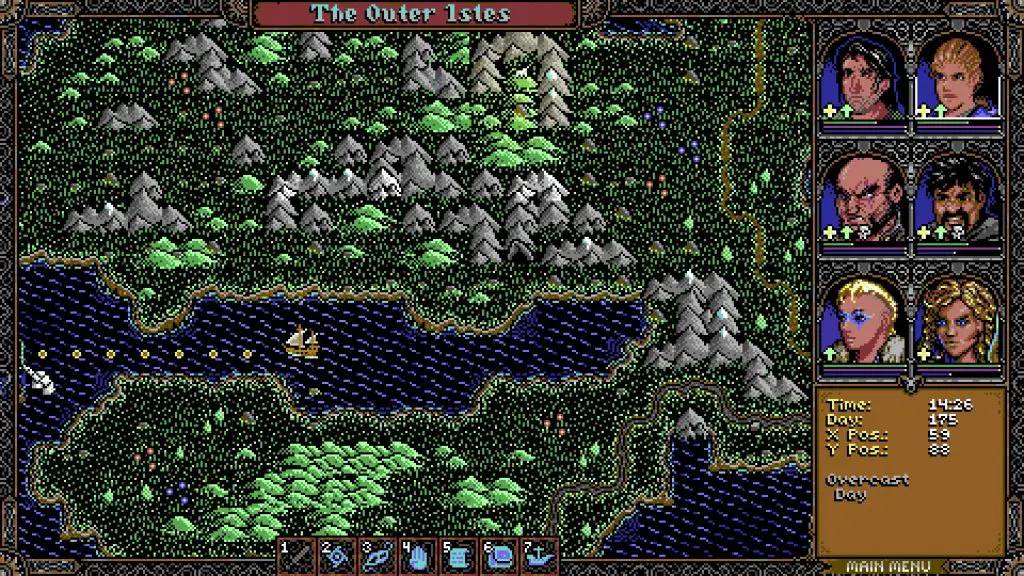
ROLEPLAYING
► Hand-crafted LEVEL MAPS provide an interactive platform for quests to take place in. Most are small to average in size. Rather simple in nature. Apart from a very few that are large and filled with intricate layouts, where complex quest branches take place. Hand-crafted visuals give these a diverse and interesting look. Navigating can feel directionless since there is no mapping or compass to orient the player, only coordinates. An aspect further complicated by the quirky way terrain is revealed every time it is walked over. A hindrance to adequately gauging where the party has previously been. This can cause frustrating delays when locating objectives.
► QUESTS are standard fare coming in the form of a meticulously scripted main quest branch divided into self-contained chapters. Each must be completed to allow the party to move on. Most clues will be straightforward for an average gamer, but some are vague enough to be confusing. Further compounded by the lack of purposeful navigation. A few quests offer alternate resolution paths, such as using stealth rather than fighting. Some side-quests can be missed or remain unresolved if the ‘wrong’ dialogue option is chosen.
► Stat-based checks inject challenge into the monotony of ADVENTURING. Choosing which party member makes the roll, is a nice touch. Along with NPCs to talk to, hidden loot containers to find, recipe ingredients to collect, and enemies to fight, there are locked entrances and chests to open or lockpick. Hidden loot containers can only be found if spotted. Climbing access points from elevations can have ropes attached to avoid stat checks. A dedicated alignment system monitors relations with factions, but not party members. Stealing from traders uses a counter-balance mechanism that increases prices instead. Spells can be used to heal and forego the need to camp. While stealth, when used in exploration mode, can avoid unnecessary or unwanted encounters.
► CAMPING is a great vehicle to regenerate health, wounds, and mana, which would otherwise require the use of potions and spells. Initiated when the party needs to rest, it can done in areas free from hostile encounters or where there are beds. The food mechanic that allows for the recovery of health and wounds, is made interesting with a wealth of recipes that require ingredients. However, its poignancy begins to diminish around mid-game when characters become less susceptible to taking damage. Camping activities allow the party to forage for food, fletch arrows, generate morale, or party XP while they rest. However, these are capped to stop this feature from being abused.
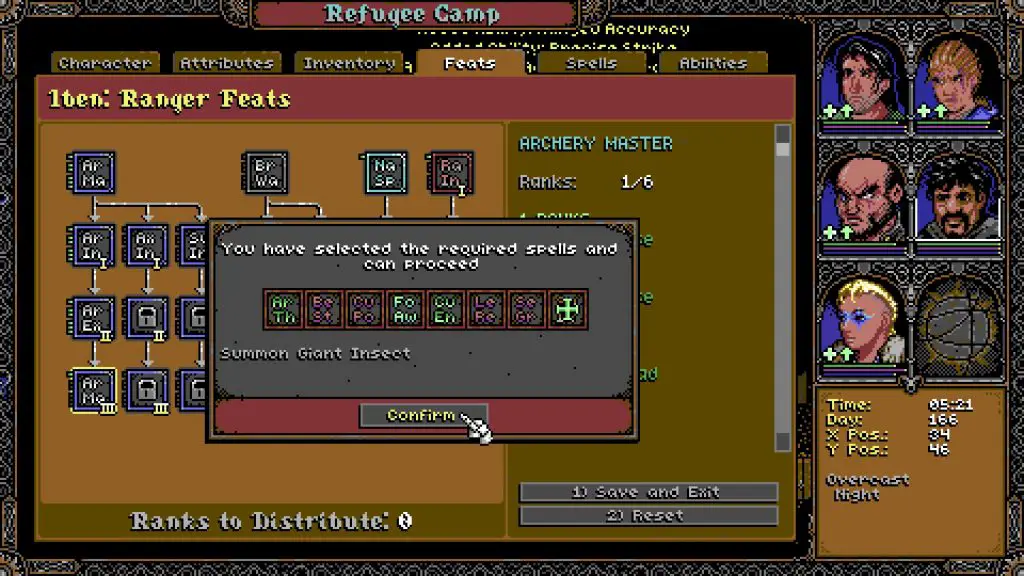
party & Characters
► PARTY SET-UP allows players to create their own starting character from a number of familiar and unfamiliar classes. Pre-made story-based followers are recruited organically. A slow process as a full party is only possible around mid-game. Upon joining, skill points are assigned en masse up to a comparable level to existing party members, allowing for the customization of preferred builds. To plug the gap vanilla characters (mercenaries) can be hired at strategic locations and are also customisable. Once the party reaches more than six individuals, the camp feature can be used to swap out those that are unwanted.
► A mix of x9 standard and non-standard classes breath life into CHARACTER BUILDING. Leaders, melee and ranged attackers, spell-casters, a healer and a thief, each with their own advantages and disadvantages, can be given backgrounds that define primary stats – an important feature of adventuring. Each has a skill tree of multiple branches to specialise those class-based stats further, preferred armour and weapons and gain tactical abilities or spells from several branches of magic. Careful selection can provide the flexibility to create what are essentially sub-classes. Tactical abilities are split into passive, tactical and triggered ability categories, each one having their own role to play during combat.
► INVENTORY consists of a generous collection of the usual sort of LOOT. A host of mundane and enhanced items such as weapons, armour, trinkets and the like. Defined by a number of quality tiers and magical capacity. Characters have a generous number of equipment slots plus a shared inventory to carry what they can. Limited only by encumbrance. Throughout the journey, rewards and random loot tend to be on the poor side. Only those found after significant fights or at important sites tend to offer better items. At least there are traders in many places to declutter or acquire badly needed items. CRAFTING of food and potions is involved due to the volume of options. These require specific ingredients and reagents at defined by a multitude of recipes to be found or purchased.
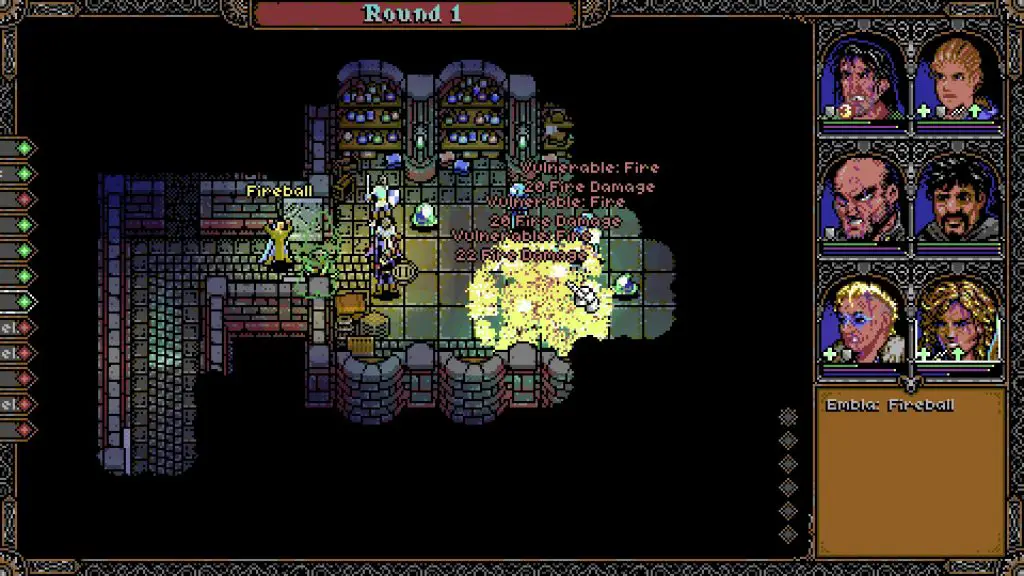
Tactical Combat & Magic
► Turn-based tactical COMBAT is pretty enjoyable throughout the game. Employing as it does, several layers of mechanics generate plenty of considerations to ponder over. Though not enough to overburden decision-making. A mixture of viable and tougher fights starts with deployment to highlighted tiles. These are fought using melee, ranged and magic attacks and optionally summoned allies. Sometimes, terrain allows bottlenecks to be taken advantage of. Though there is no line-of-sight or elevation to utilise.
The range of tactical abilities makes combat shine, and unlike in other games, it gives the party a coordinated feel. Examples include: rallying, mighty strikes, morale buffs, extra attacks, to attack and parry in the same action, backstabbing, hiding from sight and charge attacks when reaching opponents. Cooldowns ensure that these cannot be abused. A simple morale system give bonuses to buffed individuals and forces faltering opponents to run or miss their turn in panic. Characters have a two-tier health and wound injury system, which affects their ability to fight at 100% until fully rested.
► Spells come in several familiar branches of MAGIC; Spirit, Fire, Mind, Body and Nature. Each one available to corresponding classes. These bring a predictable mixture of buffs, debuffs, healing and regeneration, together with spells to attack and defend. A few allow the summoning of allied creatures. Depending on the spell, selective casting can be done in and out of combat. Unlike tactical abilities, they aren’t restricted by cooldowns; instead, they cost an appropriate amount of mana to use. One of the most noticeable issues of the game is an imbalance in magic, particularly the fire branch, which has spells that are underpowered.
► In keeping with the RPG dynamic, ENEMIES tend to be creatures outside or beneath towns, and humanoid within their boundaries. Apart from some random encounters. Many battles are mundane with rewards being on the pathetic side. At least quest and end-of-chapter foes are fairly satisfying to overcome. If anything, more Lovecraftian-themed horrors would have been welcome. Enemies mostly use melee. Some make use of abilities, and a few have ranged attacks. Fewer still have magic-casting abilities.
► The AI is competent for the most part. Melee enemies use speed to intercept. Often ganging up on isolated party members or those on the flanks. Ranged attackers stay put and attack from a distance. Weaker enemy mobs flee when the rest of their group has been slaughtered. In some encounters, it benefits from better-starting positions and will try to flank any use of bottlenecks by the party.
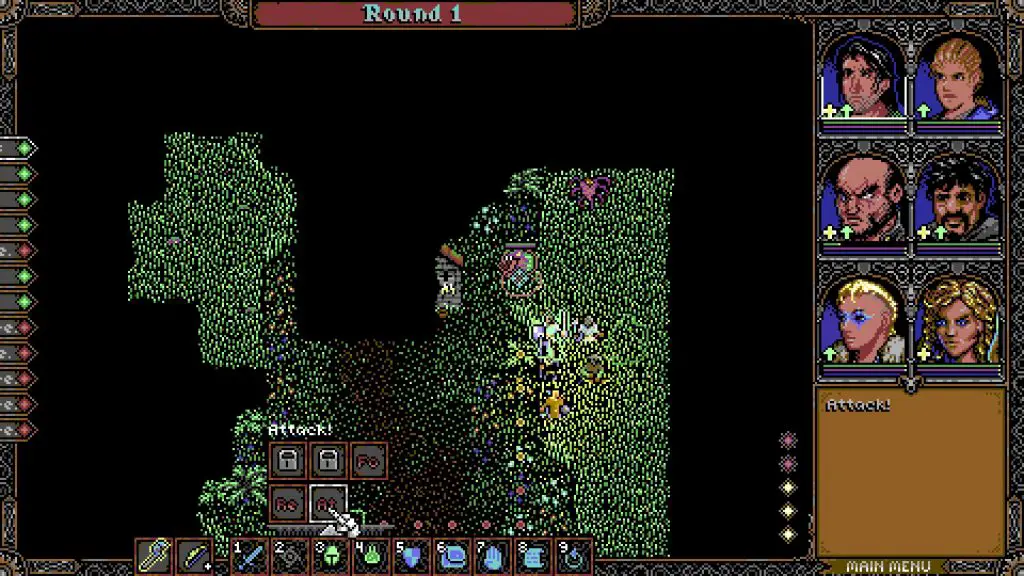
technical
► AUDIOVISUALS are both retro-inspired. The use of pixel-based tilesets certainly capture that old-school look of past classics. Though immaculate, they can be hard on the eyes of older gamers, especially on levels that are coated with similar hues and colours. The midi tunes of the deluxe version are a fine accompaniment to the game, though limited in what they add to the overall ambience. Unfortunately, but understandably, there is no voice acting to give the narration a little more oomph.
► The UI is basic, but functional. The font can be hard to read in places. It could do with a some QoL, particularly the party’s shared inventory, which is substantial but lacking in options to sort and reorganise manually. Combat states appear cramped due to the proximity of characters affecting readability. Here, a combat log could have been a better option. There is also no XP gauge on character portraits, so level progression must be specifically hunted for.
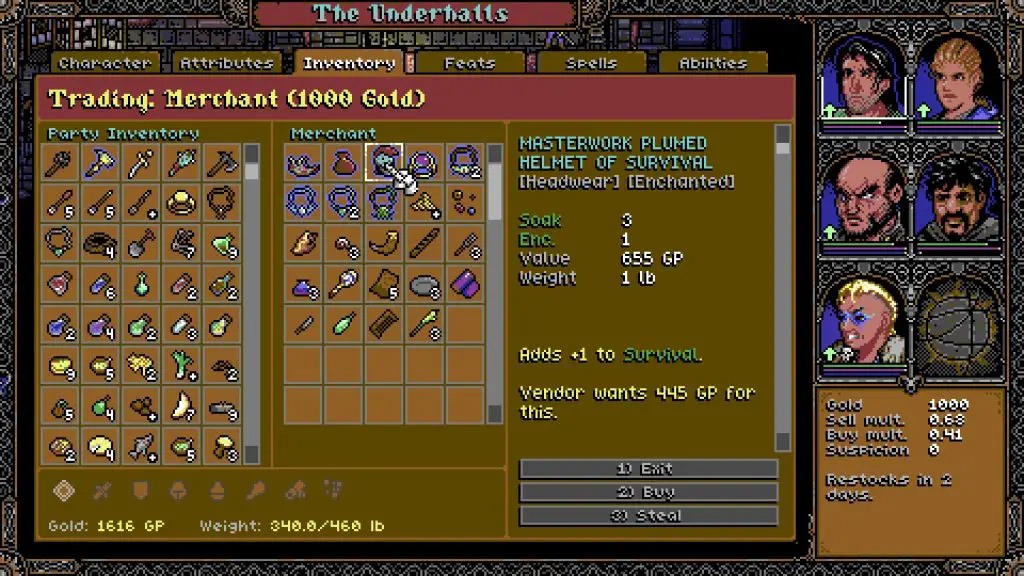
Complexity
🔶 ACCESSIBILITY – No separate tutorial, just organically occurring info screens with the introduction of new concepts. The retro style, look and font sometimes make reading tooltips hard to follow.
🔶 DIFFICULTY – There are x4 settings which can be customised which can be changed on the fly. A nice difficulty curve starts off easy enough, with harder challenge developing with progression. Most encounters are within the capability of the party. There is no retreat option, but save games can be reloaded on death. A few significant dialogue choices can lead to failure, so these need to be carefully chosen.
🔶 BALANCE – Feels quite balanced apart from spell and weapon damage which seems purposely capped. Perhaps to keep stop overrunning enemies too quickly. Some classes are overpowered. Others are underpowered. Since quest branches are self-contained there is little reason to grind for XP.
🔶 PACING – The game starts slowly with a prologue, but builds up better after the first chapter. The rate of party growth is restricted due to the scripted nature of the experience. A similar thing can be said of inventory availability.
🔶 SCALING – Party and enemy capabilities rise organically across chapters. Due to its scripted nature and with the slow introduction of story-based NPCs. Stronger equipment only becomes available with progression.
staying power
🟨 REPLAY VALUE – Even with the random encounters on the world map, there are only a few alternative quest resolutions to experience. Missed side-quests will provide some incentive to replay. Most will come through the use of different party configurations.
🟨 LONGEVITY – There is little to return for apart from experiencing the great story and the use of different classes. Achievements can be completed in a solitary, careful playthrough.
production
🟣 QUALITY – The game has a fair amount of refinement in spite of the purposely made retro look. It’s playable and can be completed. Has limited language translations. There are numerous bug reports, the more serious of which can affect the experience, but console workarounds exist for some. The writing does have some grammatical and spelling errors.
🟣 STABILITY – No crashes experienced.
🟣 STEAM – Quest-driven achievements. Cloud saving. Overlay screenshot capture. No controller support.
🟣 OPTIMISATION – Some slowdowns were experienced in a few locations mid-game. Also reported by other gamers.
verdict
SKALD: Against the Black Priory is a credible pixel-styled RPG that scratches that retro-inspired itch. Its grim fantasy world is different, but familiar in other ways to the epic classics of yester-year. Overly scripted quest branches result in a lack of alternative pathways, but the adventure is rich due to its horror-soaked story, interesting characters and well-written story. Layered party-based TBT combat is enjoyable but would be served better if the shackles were taken off weapon stats and damage-dealing abilities. The magic system is disappointing and needs a considerable tweak to make it satisfying to use.
There are flaws such as slowdowns, a font that affects readability and some quest options that fail to materialise or are curtailed though dialogue choices. Due to the successful reception the game has received some of these are being worked upon and after a week there has already been a sizeable update.
SKALD is already a WORTHWHILE play, yet it would have rated higher bar its flaws, a stronger populated game world and more optional quest branches. Even at the risk of unbalancing the game a little.
